
views
Brushing Your Hair

Divide hair into sections before brushing. Before putting that brush to your locks, divide your hair into 2-4 sections, and gently work your comb or brush through each section. If your hair is already tangled, move slowly and gently, working through knots with careful movements. The thicker your hair is, the more sections you should use. Brushing through small sections of hair will aid in keeping hair smooth and frizz-free, which can help prevent knots. Once you have combed through all sections, run the brush once or twice through all of your hair to minimize the appearance of parts and sections.
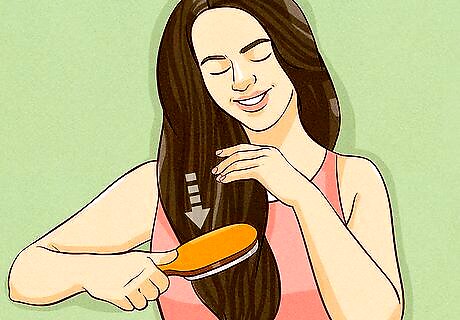
Brush from end to root. If your hair is tangled, moving from root to end can worsen knots and cause pain. Instead, grasp your hair by the middle of the hair shaft, and brush from the middle down. Work your way up, gently easing any tangles that might have developed. If the ends of your hair are knotted, start at the tips and work your way up. This is a great way to avoid tangles, as well; brushing from the mid-shaft down, then going from the root down will sort through any stray hair or flyaways, and will help your brush avoid yanking.
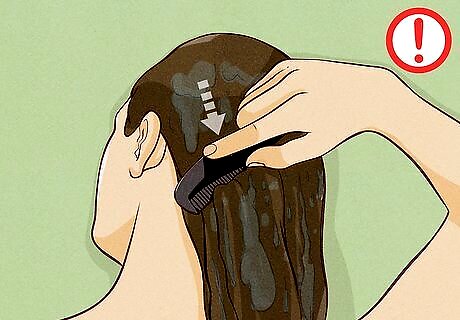
Avoid brushing wet hair. To keep knots at bay, avoid brushing wet hair. When brushing wet hair, you run the risk of stretching and breaking it, which increases the risk of developing tangles. Instead, brush hair only when damp or dry. If you cannot avoid brushing wet hair, do so with a wooden, wide-toothed comb, and move slowly and gently. Even with a wide-toothed comb, you should approach any existing knots gently. Separate the knot as much as possible with your fingers, then move on to combing.
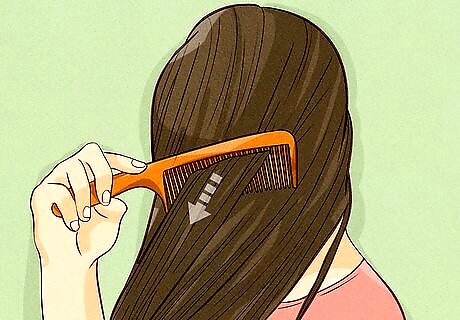
Comb your hair with a wide-toothed comb. Fine-toothed combs are great for short hair (think 1-2 inches and shorter) and facial hair, but are very quickly damaging to tangled medium-length and long hair. Instead of a fine-toothed comb, use a wide-toothed comb. Although plastic will do, plastic combs often have small barbs and rough edges that can damage hair. If possible, use a comb made of wood or bamboo for a smoother, gentler finish. Once you have detangled your medium or long hair, you can use a fine-toothed comb on it. If the hair is still knotted, however, it may cause more breakage.
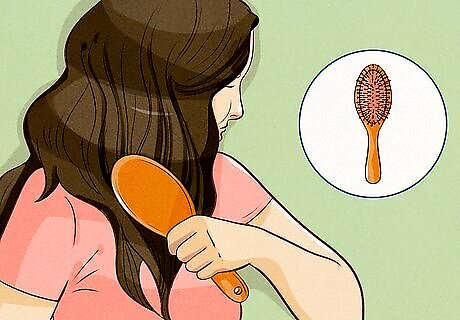
Brush your hair morning and night with a boar-bristle brush. Once you’ve worked through your hair with a comb, brush your hair (morning and night) with a boar-bristle brush. Boar-bristle brushes are gentle on the hair shaft and spread natural oils evenly throughout the hair, leading to fuller, moisturized, healthy hair, rather than dry or brittle hair. Dry, brittle hair results in knots and tangles, so minimizing dryness is a must. When brushing with a boar bristle brush, brush in sections, and finish by turning your head upside-down, brushing from the base of your hairline to the crown of your head.
Cleaning and Styling Your Hair
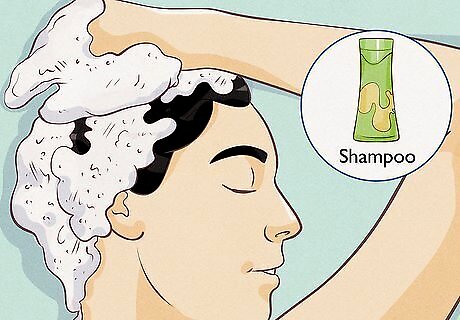
Shampoo your roots only. When you shampoo, start at the root, and work your way to the middle of your hair, avoiding the ends altogether. Instead of scrunching your hair into a bun and lathering all of your hair with your shampoo, leave the ends of your hair down, and work your shampoo through your hair, massaging your scalp as you do so. The shampoo will run down your hair to the tips, so you don't need to apply shampoo to the ends directly. Shampooing can be extremely drying. If you are prone to dry hair, shampoo only once every other day, or even once per week. If you put shampoo directly on the ends, it can dry your hair out, leading to more tangles.

Condition the ends of your hair. Whether or not you shampoo the ends of your hair, you ought to condition them. Use a traditional rinse conditioner or a leave-in conditioner. Starting at the middle of the hair shaft, work conditioner down the hair shaft, avoiding the roots. This will keep the ends of your hair soft and pliable, while avoiding excess oil at the root. One of the most common causes of tangles is dryness. Keeping your hair moisturized and healthy will cut down on tangles.
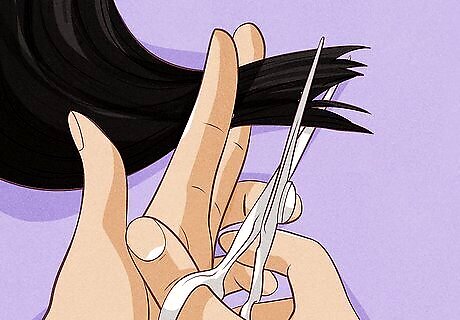
Trim your hair regularly. Aim to get a trim every 6-8 weeks. Regular trims will stave off split ends and breakage, which can lead to knots and tangles. If you notice split ends in between trims, you can even perform a quick trim yourself, or increase the frequency of your hair appointments. Split ends are usually caused by dry, damaged hair, so if you notice a recurrence of split ends, trim more often. If you do trim your hair yourself, instead of a licensed cosmetologist, avoid cutting extreme lengths, layers, and cutting straight across. Instead, cut in small sections, holding your scissors at a slight angle to keep the ends even.
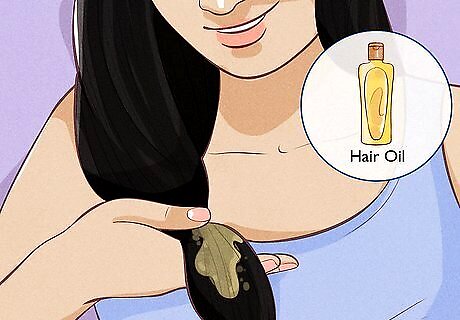
Enlist the help of hair oil daily. Like conditioner, hair oil can be used to smooth and moisten hair ends. You typically want to avoid using hair oil at the root, but can use a gentle hair oil from mid-shaft down. Not all oils are created equal. Although coconut and olive oil can be great for hair treatments, they are not ideal for everyday use, as they can weigh hair down. Opt for a thinner oil, such as argan, when searching for an everyday hair oil. Less is more where hair oils are concerned. Use only one or two drops, rub the drops between your hands, and comb your hands through the ends of your hair. Your hair should not feel stringy or damp following the application of hair oil. If it does, you have used too much oil, or the oil is too thick.
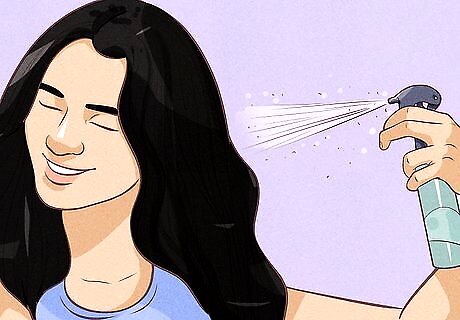
Use a detangler, when necessary. Sometimes, tangles will prevail despite your best efforts. In these cases, a detangler can help soften and loosen hair to make brushing through existing tangles and avoiding additional tangles easy. Even with a detangler, however, be careful to use a wide-toothed comb rather than a brush or fine-toothed comb. When purchasing a detangler, pay close attention to the ingredients. The ingredients should be moisturizing (think oils), rather than drying. If a detangler has alcohol or other drying agents in it, it may do more harm than good. If you do not have a detangling spray, mix ⅓ cup of filtered water, ⅓ cup of apple cider vinegar, and 1 teaspoon of oil. Using a spray bottle, spray this mixture onto your hair and comb through as usual.
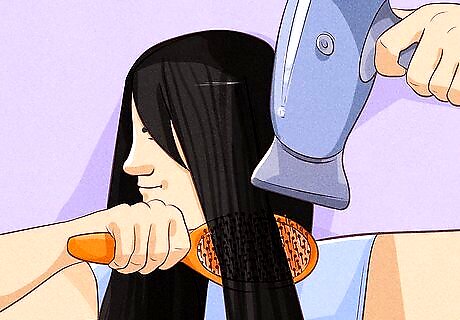
Blow-dry your hair straight down. While placing your blow dryer underneath your hair and blowing up may give you added volume, it will also create a mass of tangles. Instead, blow dry your hair using a round brush or stiff-bristled brush, and pass the dryer along your hair shaft in smooth, long strokes. Using a dryer too often can result in breakage. Avoid drying when you are able, and refrain from holding the dryer closer than 4-6 inches.

Tie braids or buns with a nylon band. Hair ties can contribute to breakage. Small rubber bands are particularly harmful, though thread-wrapped bands can also lead to breakage via the hair tie’s seam. To avoid breakage, use a nylon band whenever possible. You can purchase nylon bands from your local supermarket or beauty store. Look online as well. You can make your own using an old pair of tights. To make your own, simply cut your tights into 1-inch strips width-wise. Nylon bands will stretch out faster and easier than rubber bands, so expect to get only 2-3 months’ use out of each one. Because they don’t last as long, cutting up old, unused nylons is the more economical option.
Using Sleep Techniques

Braid or tie your hair up before hitting the pillows. One of the easiest ways to tangle hair is to sleep on loose hair. Avoid going to sleep with loose hair, instead opting for a braid or loose bun. This will keep your hair strong and contained, and turning your head throughout the night will not result in knots. Use nylon hair ties during the night, especially, as you will likely experience some tossing and turning. Rubber bands can dig into the hair during this time, causing breakage overnight. All sleep styles should be done loosely. A tight ponytail, bun, or braid will tug on hair and risk breakage. A loose french braid or loose, low bun are the safest options.
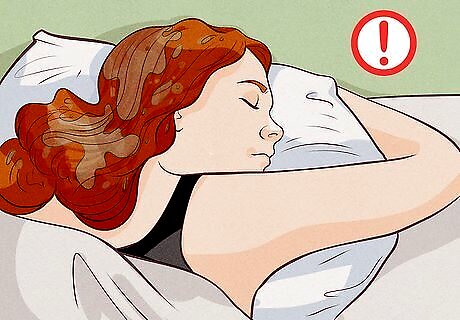
Avoid sleeping with wet hair. If possible, do not go to sleep with wet hair. When hair is wet, it is far more prone to damage. Tossing and turning while your hair is drying can create frizz, rather than a smooth hair shaft, which leads to tangles. If you must sleep on wet hair, be sure to comb with a wide-toothed comb, and place in a braid or bun first. If you prefer showering at night, try to do so at least an hour before going to bed. On days when this is not possible, you can use a hair dryer on its lowest setting. If you do this, be sure to brush your hair before getting into bed.

Use a silk pillowcase. Cotton, polyester, and similar fibers can make hair more prone to tangling. This is largely due to the nature of the cloth; these fibers are usually somewhat rough in texture, which can catch hair strands, and cause knots or damaged shafts. Instead, use silk pillowcases so hair can move freely, without catching or knotting. This does require a bit of an investment, as silk pillowcases are not cheap. Be careful when choosing your pillowcase. Search for 100% silk, and avoid satin and other synthetic fibers.
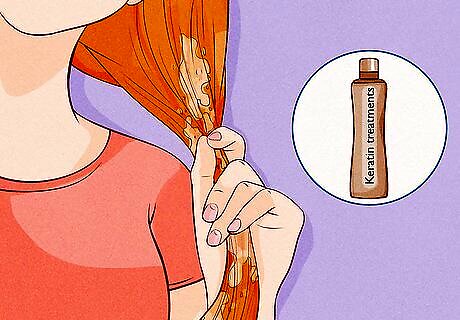
Apply a conditioning treatment overnight. Conditioning treatments are best left overnight, and rinsed off in the morning. Apply a treatment before bed. Wear a shower cap or lay a towel on your pillow to avoid staining. Leaving the conditioner on overnight with ensure your hair shaft soaks up as much of the moisture as possible, while keeping your hair strands slick and smooth, allowing them to slide against each other freely. Oil treatments are best for dry, coarse hair. Use treatments with argan, olive, or coconut oil for thick, dry hair. Keratin treatments can be supplemented using oils. Fine, thin hair is best helped by lighter ingredients, such as keratin. If your hair is fine or thin, oil might weigh your hair down and should be avoided. A hydrating hair mask can also help a lot keeping your hair in great shape, avoiding tangles.
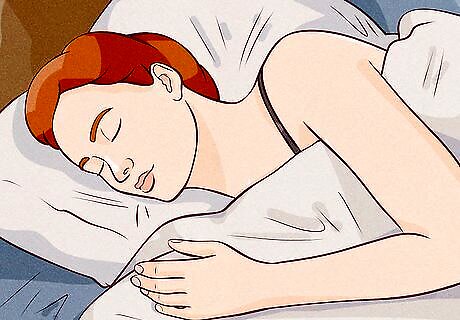
Ensure deep, uninterrupted sleep. Tossing and turning lends itself to tangles. One of the simplest ways to avoid tangles is to get good-quality sleep, where your body does not require a lot of moving around. When you get ready for bed, try to relax and create a calming sleep environment. To help yourself relax before bed, drink a warm cup of tea and read a book or listen to soothing music. Avoid using electronics right before bed, as the blue light from electronics can disrupt sleep cycles and lead to fractionated sleep, resulting in more movement and additional knots.



















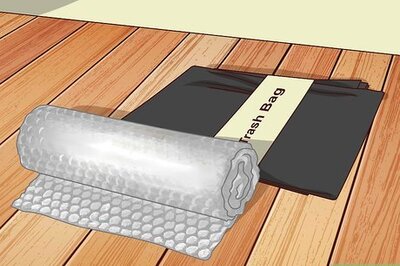
Comments
0 comment